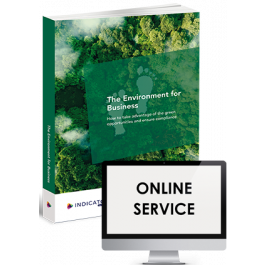The Environment for Business
How to take advantage of the green opportunities and ensure compliance
A Tips & Advice book about...
In a nutshell
The goal of this book is simple - to keep your business on the right side of environmental legislation, avoid enforcement action and take advantage of the green opportunities.
In detail
How we manage and protect the environment is becoming the number one challenge for many governments and legislators. This means ever more onerous environmental burdens placed on businesses relating to waste, pollution, water, energy, emissions, etc.
Along with the challenges there are opportunities in the green economy, but knowing how to take advantage of them can in itself be a challenge.
That’s why we created this book – aimed at businesses just like yours it unravels the legislation, explains what you have to do to stay compliant and provides details of the many “green” opportunities waiting to be taken advantage of.
It’s essential reading for all businesses concerned about the environment and keen to take advantage of the opportunities.
We've created this Tips & Advice book especially for...
All businesses
- concerned about the environment and keen to take advantage of the opportunities.
You'll get the following free extras with this Tips & Advice book...
An online service
- To immediately apply our advice and solutions in practice
- That you can easily adapt to suit your own requirements
In this Tips & Advice book you'll read about...
Part 1 - Foundations in environmental management
1. Interaction between business and the environment
1.1. What is “the environment”?
1.2. What’s your impact on the environment?
1.3. Environmental gap analysis
2. Legal reasons to manage your environmental impact
2.1. What legislation applies to your business?
2.2. The global climate agreement - are you affected?
2.3. What are the Environment Act 2021 targets?
2.4. The polluter pays - what does this mean?
2.5. Why have an environmental policy statement?
2.6. Communicate your carbon reduction measures
2.7. Green legislation weaker after Brexit
2.8. What does Natural England do?
3. Ethical reasons to manage your environmental impact
3.1. Should you have a CSR policy?
3.2. Should you worry about ESG?
3.3. What’s your carbon footprint?
3.4. What is biodiversity net gain?
3.5. Communicate green initiatives to staff
4. Financial reasons to manage your environmental impact
4.1. Changes to carbon reporting demands
4.2. Are you reading your electricity bills properly?
4.3. The rising cost of water
5. Barriers to good standards
5.1. HSBC suspends banker over “nut job” climate comments
5.2. Environmental performance report
6. Documents
Part 2 - Enforcement
1. The role of enforcement agencies
1.1. Who’s who at the Environment Agency?
1.2. Options for enforcement officers
1.3. Can you be incentivised to comply with regulation?
1.4. The EA - helpful or a thorn in your side?
1.5. New powers to conserve land and property
2. Prosecution
2.1. Enforcement trends
2.2. Is co-operation with the EA the best option?
2.3. A different approach to enforcement?
2.4. Are climate lawsuits a possibility?
3. Tips to avoid being prosecuted
3.1. How to avoid being prosecuted
3.2. How to avoid a costly court case
3.3. It’s not just enforcement agencies watching you
4. Documents
Part 3 - Environmental management systems
1. What is an environmental management system?
1.1. Describing your environmental management system
1.2. Is your management system effective?
2. Reasons for implementing an EMS
2.1. Why use an EMS?
2.2. Simple certification of management system
2.3. Certified environmental management systems
2.4. Demonstrating green credentials
2.5. Benefits to disclosing your environment performance
3. Key features of an effective EMS
3.1. What environmental information should we disclose?
3.2. Environmental management responsibilities and organisation
3.3. Environmental objectives and targets
3.4. Assess environmental risks
3.5. Do you know your “aspects” from your “impacts”?
3.6. Environmental benchmarking and continual improvement
3.7. Briefing staff on ISO 14001
4. Documents
Part 4 - Incident management
1. Legal requirements regarding pollution
2. Links to your EMS and recognising risk situations
2.1. Defining the scope of your plan
2.2. Key features of the plan
2.3. Business risks
3. Dealing with emergency situations
3.1. Pollution incident response plan
3.2. Need for prompt action
3.3. Acting responsibly after a pollution event
3.4. Environmental incident investigation report
3.5. Environmental incident - witness statement
3.6. Non-conformance and corrective action record - environment
4. Documents
Part 5 - Energy management
1. Energy and business use
1.1. How to save energy and money in the office
1.2. Managing your energy consumption
1.3. Not a smart use of energy
1.4. Energy efficiency - powerless to act?
1.5. Selling the energy saving message
2. Good practice for energy management
2.1. Energy white paper
2.2. Energy management standards
2.3. Remember to comply with energy scheme obligations
2.4. Control your radiators and save energy
2.5. Who needs an energy performance certificate?
2.6. Can we save money on compressed air?
2.7. Developments in LED lighting
3. Alternative energy solutions
3.1. Time to think again about solar power?
3.2. Trends in on-site energy generation
3.3. Hydrogen boilers - are they an option?
3.4. Biogas market opened up
3.5. Clean energy - what does it really mean?
3.6. Is it time to buy clean energy?
3.7. The greenest roof
4. Documents
Part 6 - Air quality
1. Why is air pollution such a big issue?
1.1. The threat of ambient air pollution
1.2. What is being done about air pollution?
1.3. Climate phrase confusion
1.4. What are “Scope 3” emissions?
1.5. Air pollution from construction
1.6. Should your fire risk assessment cover the environment?
2. How does limiting pollution affect your business?
2.1. Register of environmental legislation - air
2.2. Carbon emissions plans
2.3. Should your business go net zero?
2.4. Think before you offset carbon emissions
2.5. Emissions rules for off-road machinery
3. What you can do to minimise the damage
3.1. Homeworking cuts carbon
3.2. New BAT regime coming
3.3. Business travel policy
3.4. Electric vehicles are the future
3.5. Are hydrogen-electric vehicles worth a look?
3.6. Why are plug-in hybrids under scrutiny?
3.7. Is it time to ditch ageing vehicles in London?
3.8. Low carbon couriers
4. How authorities deal with air pollution
4.1. Penalties for F-gas violations
4.2. Updated F-gas guidance
4.3. Record Environment Agency fines
4.4. Waste fires are too prevalent says agency
4.5. Consistently ignoring their duties
4.6. Large fine for burning hazardous waste
5. Documents
Part 7 - Water
1. The need for water conservation
1.1. Industrial water use
1.2. Water pollution
1.3. Sources of industrial pollutant
1.4. Water quality indicators
1.5. Control methods
1.6. Monitoring requirements and arrangements
2. Regulatory framework
2.1. National action to preserve water resources
2.2. High expectations for water industry reform
2.3. Water companies under pressure to prevent environmental harm
2.4. Water stress
3. Enforcement
3.1. Register of water protection legislation
3.2. Environmental permits
3.3. How to avoid a water company fine
3.4. Water abstraction rules
3.5. Water abstraction licences revoked
4. Water pollution
4.1. Use a water pollution risks checklist
4.2. Responding to an environmental incident
4.3. Failure to self-monitor linked to pollution incidents
4.4. Emergency spill procedures prevent water pollution
4.5. Water pollution that could have been prevented
4.6. A river ran purple
4.7. Water companies clamping down on sewer pollution
5. Water use reduction
5.1. Develop a water efficiency policy and procedure
5.2. Protect your business from water shortages
5.3. Prevent winter water leaks
5.4. Have you considered recycling your water?
6. Documents
Part 8 - Waste and contaminated land
1. What is waste?
1.1. Waste types
1.2. The business case for minimising waste
1.3. Impacts from waste
2. Legalities of saste
2.1. A definition of waste
2.2. Register of environmental legislation - waste
2.3. Environmental waste exemptions
2.4. Waste strategy and changes to packaging regulations
3. Responsible waste management
3.1. The waste hierarchy
3.2. How to apply the waste hierarchy
3.3. Waste minimisation, recycling policy and checklist
3.4. What is “zero waste to landfill”?
3.5. Selecting a new waste contractor
3.6. Disposing of cooking oil
3.7. How to get rid of asbestos sheets
4. Contaminated land
4.1. Contaminated land know-how
4.2. Remedies for contaminated land
4.3. Landmark Japanese knotweed case
5. Enforcement
5.1. What could go wrong?
5.2. Waste criminals preying on naive businesses
5.3. Construction sector needs to tackle waste crime
5.4. Fine for lack of waste transfer notes
5.5. Poor storage of waste led to fire
5.6. £500,000 fine for illegally storing waste
6. Documents
Part 9 - Noise
1. What is environmental noise?
1.1. You are the cause of noise
1.2. Dealing with a noisy neighbour
1.3. Neighbourhood noise responsibilities
1.4. How to reduce noise complaints
2. Legal considerations
2.1. Planning permission
2.2. Court of Appeal noise cases
3. Managing noise
3.1. Managing noise complaints during the summer
3.2. Liability for commercial tenant’s noise
3.3. Managing noise at live music events
4. Documents
Part 10 - Green marketing and CSR
1. What is green marketing?
1.1. Green claims - practical guidance
1.2. Making the most of your legal obligations
1.3. Exploiting green marketing potential
1.4. Marketing green products
1.5. Promoting your packaging policies
2. Disadvantages of green marketing
2.1. “Going green” to the extreme
2.2. How to avoid greenwash penalties
2.3. Should you be a “Green Achiever”?
3. Corporate social responsibility
3.1. Policies
3.2. SMEs aim low on sustainability
3.3. Working around protected species and heritage
3.4. Are you ready for a climate change supplier contract?
3.5. Sourcing greener materials at a reasonable price
3.6. The return of carbon labelling?
3.7. Will there be a “latte levy”?
4. Documents
Part 11
Cars and tax breaks
1. General treatment of environmental expenses
1.1. How tax deductions are calculated
1.2. Capital expenditure qualifying for 100% deduction
1.3. Enhanced capital allowances
1.4. Terms and conditions for enhanced capital allowances
1.5. Company cars
1.6. Fuel for company cars
1.7. Appendix
Special subscribers' offer
£100.00
£80.00
Only if you already have a subscriptionStandard offer
£100.00

Got a question? Call Customer Services
(01233) 653500


 (01233) 653500
(01233) 653500 







